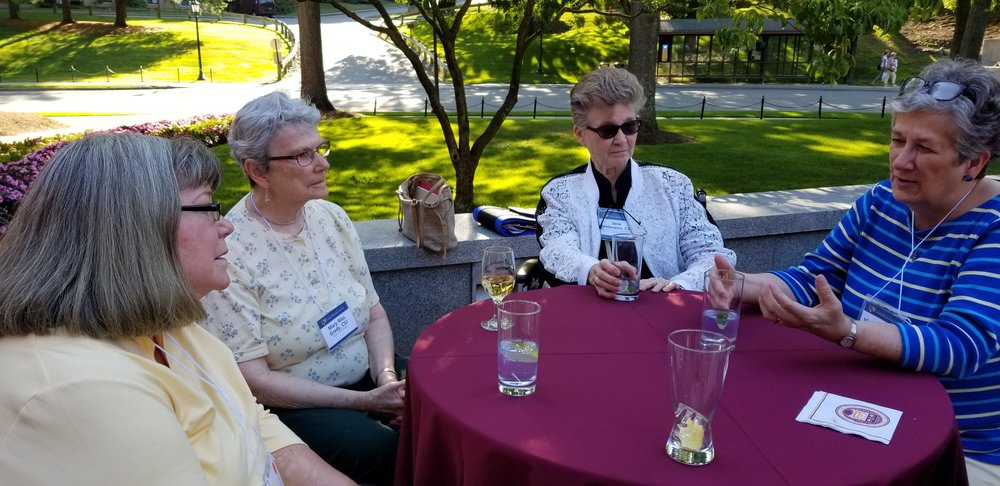Recently I had one of those strange Déjà vu moments. It was triggered by a photo of our sisters in Rome standing in front of the imposing baldacchino in St. Peter’s Basilica. It brought back the memory of the first time I was bee-wildered by the Barberini bees. ‘What kind of bees are they?’ you might ask. Undoubtedly, you know about honey bees, but Barberini bees? Well, they are honey bees, and there are literally hundreds of them in St. Peter’s. You can find them on those four imposing pillars of the baldacchino and throughout the Basilica, carved in stone, cast in metal, embroidered on silks. As I said, I was bee-wildered by the swarming bees.
So, why bees in St. Peter’s Basilica? Well, “the Barberini were a family of the Italian nobility that rose to prominence in 17th century Rome. Their influence peaked with the election of Cardinal Maffeo Barberini to the papal throne in 1623, as Pope Urban VIII.” (www.wikipedia.org) Displayed on his family’s coat of arms were three golden bees, which before long were pushed into the spotlight. During Urban’s reign bees were scattered over buildings, fountains, sculptures, tapestries and various artefacts - and of course in St. Peter’s Basilica. The famous Bernini was commissioned to design a massive bronze baldacchino in the centre of the Basilica, above the high altar. The upper parts of these massive columns are decorated with sprays of gilded bay leaves in which, yes, you guessed it, bees flutter.
Not only were bees considered symbolic of moral virtue, but their sweet honey was even compared to the Word of God as can be read in psalm 119. In addition, they produced wax for candles. Then, as now, bees appear to work extremely hard. (And to this day we refer to the hard working as ‘busy bees.’) However, there are far greater reasons for the bee-wildering presence of these innumerable bees. “In this context [they] indicate the role of the Pope as a type of Christ, and the healing power of the papacy generally … [the bee] is also an emblem of virginity standing for the Virgin birth, and the purity of Christ.” (https://Theframeblog.com/201708/22)

In spite of its relatively unimpressive size, the bee has found itself in the presence of popes. Quite an accomplishment, one might say, for such a small creature. However, how much more impressive when we think of the bee’s significance in our own daily lives. Perhaps not so much as symbolic or ornamental, but as essential to our survival. Yes, of course, we still frequently use the bee in a symbolic context. I already mentioned the ‘busy bee’. What about the ‘bee’s knees’ or ‘a bee in one’s bonnet’ or teaching kids about ‘the birds and the bees’ or taking part in a ‘spelling bee’ or helping in a ‘sewing bee?’ Ah, and then there is the ‘queen bee’. However, we are all acutely aware that bees perform a task that is vital to our survival: pollination. Did you know, one third of our global food supply is pollinated by these tiny busy bees? Simply put, bees keep plants and crops alive. Without bees, you and I wouldn't have very much to eat. How bee-wildering a thought is that?

Glory-Bee, let’s save the honey bee! Coming back to Popes and bees, did you know that on the Day of the Protection of Creation in 2011, “Italy’s largest farming association gave Pope Benedict XVI eight beehives containing more than 500,000 bees?” (www.zenit.org). Furthermore, there is a traditional practice of blessing bee hives on the feast of St. Benedict. All of us might do well to occasionally pray this blessing for these tiny creatures.
“May [your] holy blessing descend upon these bees and these hives, so that they may multiply, be fruitful and be preserved from all ills and that the fruits coming forth from them may be distributed for [your] praise and that of [your] Son and the holy Spirit and of the most blessed Virgin Mary.” (www.catholicculture.org)
As we have seen, bees, both in ancient times and in more recent centuries, have always had around them a powerful symbolic aura. For centuries people have benefitted from these industrious little creatures. Now it is our responsibility to help them survive so we, too, can survive. Sound bee-wildering? Just be bee-friendly! - Sr. Magdalena Vogt, cps









